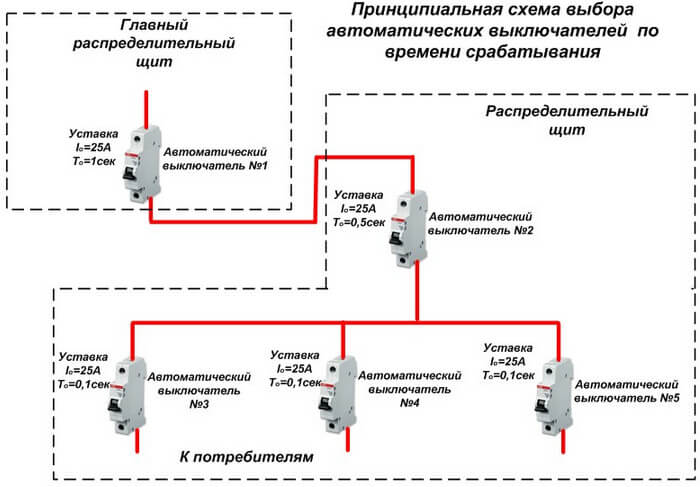What is protection selectivity?
What it is?
First of all, the concept of “selectivity” includes a protective mechanism and the smooth operation of certain devices consisting of individual elements connected in series with each other. Often such devices are various types of automatic machines, fuses, RCDs, etc. The result of their work is the prevention of “combustion” of electromechanisms in the event of threats. A diagram of the selective operation of circuit breakers and RCDs in the shield is provided below:
The advantage of this system is its ability to disable only the necessary sections, while the rest of the system remains in working condition. The only condition for this is the consistency of the protective devices with each other.
Main functions
So, the main functions of selective protection are:
- ensuring the safety of electrical appliances and employees;
- instant determination and shutdown of the power zone in which the breakdown occurred, without other shutdowns that will stop the supply of electricity in places of stable operation of the equipment;
- reducing the impact of negative consequences on the remaining parts of electromechanisms;
- reducing the load on composite installations and preventing breakdowns in the faulty zone;
- ensuring the highest possible continuous power supply of high quality;
- ensuring the continuity of the work process;
- providing qualified support in the event that the protection itself, which is responsible for opening, becomes malfunctioning;
- support for the optimal functioning of the installation;
- providing simplicity in operation and economic efficiency.
Kinds of selective protection
The selectivity of protective equipment is divided into the following types:
- Complete. Two devices are connected with serial connection, when exposed to overcurrents, only one protection is activated, which is closer to the fault zone.
- Partial Like complete, but protection only works up to a certain indicator of overcurrent.
- Temporary. The circuit includes several machines with the same current characteristics, but with a different exposure time. As a result, from the closest to the malfunction, to the most distant circuit breaker, the devices insure each other (for example, the closest one will work after 0.02 s, the next after 0.5 s, well, the last after 1 s, if the other 2 do not work) .

- Current.Roughly speaking, the principle of operation of the current selectivity of the protections is similar to the time, but only the exposure does not occur in time, but in magnitude of the current. For example, circuit breakers are installed on input 25A, then 16A, and then 10A. At the same time, the shutdown time for them may be the same.

- Vremyatokovaya. In addition to the reaction of the protection mechanisms to current, the time of this reaction is also determined.
- Zone. If a violation of the current threshold is detected, the operation of the installation allows you to accurately determine the faulty zone and turn off the electricity supply only in it.
- Energy. All damage prevention processes take place in the molded case of the circuit breaker. The shutdown occurs in such a short time that the mark of the maximum current value does not reach its result.
Also, the selectivity of protection can be absolute and relative. In the first case, only the damaged part of the circuit is disconnected. According to this principle, fuses installed in electrical appliances work. Relative selectivity protects not only “your own site”, but also the neighboring one, if absolute selective protection has not worked out in it.
Selectivity map
It is imperative to mention the selectivity map, which you will need “like air” for maximum current protection. The card itself is a certain scheme built in the axes, where all the aggregate time-current characteristics of the installed devices are displayed. An example is provided below:
We have already said that all protective devices must be connected in turn one after another. And the map displays the characteristics of these particular devices. The main rules for drawing cards are: protection settings should come from a single voltage; the scale must be chosen with the expectation that all boundary points will be visible; it is necessary to indicate not only the protective properties, but also the maximum and minimum indicators of short circuits at the design points of the circuit.
It is worth noting that in today's practice, the absence of selectivity maps in projects, especially at low voltages, has become firmly entrenched. And this is a violation of all design standards, which ultimately is the result of a power outage for consumers.
Finally, we recommend watching a useful video on the topic:
Now you know what the selectivity of protection of the electric network is and why it is needed. If you have questions, you can ask them on our forum for electricians.
It will be interesting to read:









In which program are the presented schemes drawn?
Everything is of course interesting, but ... in the first image, the wiring is not done correctly, in my opinion. The boiler and the dishwasher must be connected via an ouzo or differential automat. In your version, just the machines are shown.
the commentator should change into a suit.